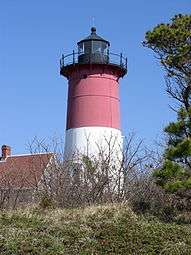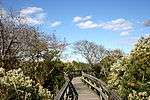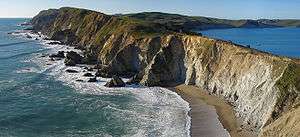List of United States national lakeshores and seashores
The United States has ten protected areas known as national seashores and four known as national lakeshores, which are operated by the National Park Service, an agency of the Department of the Interior. National seashores and lakeshores must be established by an act of the United States Congress. National seashores and lakeshores are coastal areas federally designated as being of natural and recreational significance as a preserved area. The first national seashore, Cape Hatteras, was established in 1937, and the first national lakeshore, Pictured Rocks, was established in 1966. The newest national lakeshore or seashore is Canaveral, established in 1975. All of the national lakeshores are on Lakes Michigan and Superior, and nine of the ten national seashores are on the Atlantic Ocean, including two on the Gulf of Mexico.
National seashores are located in ten states and national lakeshores are in three other states. Florida, North Carolina, and Michigan each have two. Point Reyes is the only national seashore on the Pacific coast. The largest national seashore or lakeshore is Gulf Islands, at over 137,000 acres (550 km2); the smallest is Indiana Dunes, at 15,000 acres (61 km2). The total areas protected by national seashores and lakeshores are approximately 595,000 acres (2,410 km2) and 229,000 acres (930 km2), respectively.[1]
National Seashores
| Name | Photo | Location | Date Formed[1][2] | Area[1] | Description |
|---|---|---|---|---|---|
| Assateague Island |  |
Maryland, Virginia 38°05′N 75°13′W / 38.08°N 75.21°W |
September 21, 1965 | 39,726.75 acres (160.8 km2) | As a barrier island, Assateague Island is continually shaped by wind and waves. It is known for its feral horses and is also home to deer, crabs, fox, and migrating snow geese. Main vegetation includes American beach grass, saltmarsh cordgrass and sea rocket.[3] |
| Canaveral |  |
Florida 28°46′N 80°47′W / 28.77°N 80.78°W |
January 3, 1975 | 57,661.69 acres (233.3 km2) | Adjacent to the Kennedy Space Center, this barrier island has a variety of recreational activities including hiking, boating, and fishing. The Seminole Rest features an ancient Native American mound, and Eldora Statehouse shows historic life on the lagoon. Florida's longest undeveloped Atlantic beach surrounds Mosquito Lagoon, which is home to dolphins, manatees, and sea turtles, along with a variety of sea grasses.[4] |
| Cape Cod |  |
Massachusetts 41°57′N 70°00′W / 41.95°N 70.00°W |
August 7, 1961 | 43,608.48 acres (176.5 km2) | Beyond its nearly 40 miles of beaches, this historic area has Marconi Station, the Three Sisters Lighthouses, and the former North Truro Air Force Station. Cranberry bogs, marshes, and hiking trails provide a look into the flora and fauna of Cape Cod.[5] |
| Cape Hatteras |  |
North Carolina 35°18′N 75°31′W / 35.30°N 75.51°W |
January 12, 1953 | 30,350.65 acres (122.8 km2) | Located in the Outer Banks, Cape Hatteras is known for its Bodie Island and Cape Hatteras Lighthouses. Popular recreation activities include windsurfing, birdwatching, fishing, shell collecting, and kayaking. Constantly changing from ocean activity, this barrier island provides refuge for the endangered piping plover, seabeach amaranth, and sea turtles.[6] |
| Cape Lookout |  |
North Carolina 34°37′N 76°32′W / 34.61°N 76.54°W |
March 10, 1966 | 28,243.36 acres (114.3 km2) | Cape Lookout National Seashore is made up of three islands of the Outer Banks. It is known for its wild horses and the Cape Lookout Lighthouse. Hiking, camping, fishing, and birdwatching are popular recreational activities. It is also home to two historic villages.[7] |
| Cumberland Island |  |
Georgia 30°50′N 81°27′W / 30.83°N 81.45°W |
October 23, 1972 | 36,415.13 acres (147.4 km2) | Cumberland Island is the site of the Plum Orchard estate, Thomas Carnegie's ruined Dungeness mansion, and an African Baptist church. The museum on the mainland preserves Timucua Indian history, Nathaniel Green and Eli Whitney's works, and War of 1812 battles.[8] |
| Fire Island |  |
New York 40°42′N 72°59′W / 40.70°N 72.98°W |
September 11, 1964 | 19,579.47 acres (79.2 km2) | Fire Island, a barrier island south of Long Island, has the historic William Floyd House and Fire Island Lighthouse. The beaches and dunes are complemented by a sunken forest, wetlands, and seventeen communities.[9] |
| Gulf Islands |  |
Florida, Mississippi 30°22′N 86°58′W / 30.36°N 86.97°W |
January 8, 1971 | 137,990.97 acres (558.4 km2) | Seven main islands have four historic forts built by the Spanish, British, and Americans that were used for defense in the Civil War. Apache Indians once lived here, including Geronimo. There are nature trails for wildlife viewing and long beaches for snorkeling, biking, and other activities.[10] |
| Padre Island |  |
Texas 27°00′N 97°23′W / 27°N 97.38°W |
April 6, 1968 | 130,434.27 acres (527.8 km2) | Padre Island, the world's longest undeveloped barrier island, is a nesting ground for the Kemp's ridley sea turtle and a migratory site for least terns, brown pelicans, and piping plovers. Malaquite Beach provides a variety of recreational activities, and Novillo Line Camp has the remains of a cattle ranch. The military used part of the island as a bombing range during WWII.[11] |
| Point Reyes |  |
California 38°00′N 123°00′W / 38.00°N 123.00°W |
October 20, 1972 | 71,067.78 acres (287.6 km2) | Historic locations on Point Reyes Peninsula include the Point Reyes Lighthouse and Lifeboat Station and a recreated Coast Miwok village. Gray whales can be seen as they migrate near the seashore, and tule elk and elephant seals populate the wilderness area.[12] |
National Lakeshores
| Name | Photo | Location | Date Formed[1][2] | Area[1] | Description |
|---|---|---|---|---|---|
| Apostle Islands |  |
Wisconsin 46°58′N 90°40′W / 46.97°N 90.66°W |
September 26, 1970 | 69,371.89 acres (280.7 km2) | 21 islands and shoreline on the northern tip of Wisconsin on the shore of Lake Superior. It is known for its collection of historic lighthouses, sandstone sea caves, a few old growth remnant forests, and natural animal habitats[13] |
| Indiana Dunes |  |
Indiana 41°39′N 87°07′W / 41.65°N 87.12°W |
November 6, 1966 | 15,067.38 acres (61.0 km2) | Sand beaches, small dunes and forests along southern Lake Michigan[14] |
| Pictured Rocks |  |
Michigan 46°34′N 86°19′W / 46.56°N 86.31°W |
October 15, 1966 | 73,235.83 acres (296.4 km2) | The Lakeshore includes limestone cliffs as well as sand dunes on Lake Superior. Lakeside and inland waterfalls, lighthouses, and sea caves are other attractions.[15] |
| Sleeping Bear Dunes |  |
Michigan 44°55′N 86°01′W / 44.91°N 86.02°W |
October 21, 1970 | 71,198.48 acres (288.1 km2) | Tall sand dunes, islands, forest and farms on Lake Michigan[16] |
See also
- List of areas in the United States National Park System
- History of the National Park Service
- List of National Historic Landmarks of the United States
- List of National Monuments of the United States
- Wilderness preservation systems in the United States
References
- 1 2 3 4 5 The National Parks: Index 2009–2011 (PDF). Washington, D.C.: National Park Service. ISBN 978-0-912627-81-6. Retrieved 4 February 2011.
- 1 2 "National Park System Areas Listed in Chronological Order of Date Authorized under DOI" (PDF). National Park Service. 27 June 2005. Retrieved 18 January 2010.
- ↑ "Assateague Island National Seashore". National Park Service. Retrieved 22 January 2011.
- ↑ "Canaveral National Seashore". National Park Service. Retrieved 22 January 2011.
- ↑ "Cape Cod National Seashore". National Park Service. Retrieved 22 January 2011.
- ↑ "Cape Hatteras National Seashore". National Park Service. Retrieved 22 January 2011.
- ↑ "Cape Lookout National Seashore". National Park Service. Retrieved 22 January 2011.
- ↑ "Cumberland Island National Seashore". National Park Service. Retrieved 22 January 2011.
- ↑ "Fire Island National Seashore". National Park Service. Retrieved 22 January 2011.
- ↑ "Gulf Islands National Seashore". National Park Service. Retrieved 22 January 2011.
- ↑ "Padre Island National Seashore". National Park Service. Retrieved 22 January 2011.
- ↑ "Point Reyes National Seashore". National Park Service. Retrieved 22 January 2011.
- ↑ "Apostle Islands National Lakeshore". National Park Service. Retrieved 22 January 2011.
- ↑ "Indiana Dunes National Lakeshore". National Park Service. Retrieved 22 January 2011.
- ↑ "Pictured Rocks National Lakeshore". National Park Service. Retrieved 22 January 2011.
- ↑ "Sleeping Bear Dunes National Lakeshore". National Park Service. Retrieved 22 January 2011.
External links
| Wikimedia Commons has media related to National Seashores of the United States. |
| Wikimedia Commons has media related to National Lakeshores of the United States. |
- Official website of the National Park Service
- Find a Park by the NPS
